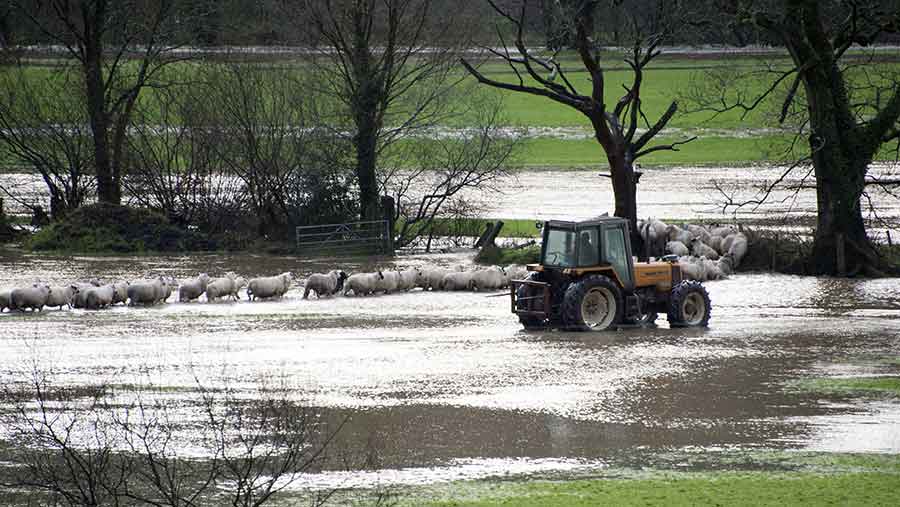Sheep farmers urged to act fast and assess in-lamb ewe condition after floods
 © David Thompson/REX Shutterstock
© David Thompson/REX Shutterstock Sheep producers need to act fast and get their hands on ewes to check the body condition of in-lambers in regions that have endured severe wet weather this winter.
It’s already clear that ewes hardest hit by the weather have lost more condition than farmers realise – a situation causing concern as early pregnancy scan results predict a bumper lamb crop.
The low feed value of waterlogged grazing has added to the deterioration of ewe condition in many flocks that have endured rain every day for almost three months.
Sheep advisers say flockmasters should assess ewes without delay, and house or re-locate ewes to avoid a crisis at lambing-time.
See also: Advice on ewe nutrition to cut costs
While sheep scanners report results in some North of England Mule flocks to be up from around 200% to 213%, some flocks in the regions worst affected by the winter’s weather have recorded rain every day for over 70 days.
Leicestershire-based sheep adviser Lesley Stubbings says ewes in the wettest areas are “slipping condition” and action needs to be taken before it’s too late to have any beneficial impact in the run-up to lambing time.
“Ewes gathered for scanning need a body condition check. The big risk sheep are in flocks that don’t scan or where ewes are away-wintered and so don’t get handled.
“Grass is wet and is low in dry-matter, but getting feed to in-lamb ewes isn’t easy where the ground is so water-logged. So producers need to house ewes if they can or get them to somewhere that affords better control of their nutrition.
“I know there may be extra costs involved but losses later could far outweigh costs incurred now if the situation is ignored,” says Ms Stubbings.
Condition score
Ewes in lowland flocks need to be in condition score 3-3.5 in the approach to lambing; any ewes in poor condition need to be managed separately, but with many flocks expecting a high number of triplets this spring, starting to feed triplet-bearing ewes early will be critical, she says.
See also: How to body condition score ewes
“No one wants a crop of unthrifty lambs and ewes with no milk – and that’s on the cards if no action is taken to assess ewe condition,” she warns.
Trials
The importance of not allowing ewes to lose condition during mid-pregnancy has been highlighted in the interim results of an ongoing AHDB trial.
It has shown that the body condition score of ewes at tupping – and when taken again at scanning – had a direct influence on the total weight of weaned lambs produced per ewe.
Vet Joe Henry of Alnorthumbria Vets says ewe condition could be deceptive when sheep were carrying heavy fleeces.
“It’s essential for farmers to get their hands on these ewes as soon as possible. You can’t put weight back on skinny ewes, but at least if you act now you can prevent any further loss in condition and avoid more problems at lambing time.”
Good quality forage – 10.5 ME plus – will help ewes to hold condition, but vets fear intakes have been hampered by atrocious ground conditions around feeders.
And Mr Henry adds that farmers needed to make sure ewes have access to water troughs.
“It may seem strange when there has been so much rain but it’s essential that ewes can drink when hay or forage is on offer.”
Fluke
Fluke problems are also being highlighted following the mild and wet conditions – and in some cases will be responsible for worsening the level of condition loss, even though ewes are receiving extra feed.
SRUC sheep specialist John Vipond advises farmers concerned about fluke risks to consult their vets without delay.
“But all many pregnant ewes need now is simply the chance to lie down in a dry place. Ewes have been unable to find any dry ground and that can be a problem in itself. We’ve had cases where ewes have been brought inside and had feed on offer, but their first instinct was just to lie down once they were given the chance of a dry bed.”
See also: How to best check your sheep for fluke
Mr Vipond says farmers worried about eating into silage stocks at this stage of the winter could offer forage to housed ewes for just part of the week.
“If ewes are fed good quality silage for five days of the week they can be given some decent big straw bales to pull at in the feeders for the other two days. Good use can be made of low cost cereals too where ewes have lost condition, but are still at least two months off lambing.
“Feeding 0.5lb of oats/head for some much needed energy is very good value and when fed alongside some forage should stop any further loss in condition.”
Meanwhile it looks like south-west flocks are also heading for a big lamb crop.
Exmoor-based sheep scanner David Takle says: “We had good weather at tupping time and our winter hasn’t been as wet as in the north. Most of the flocks I’ve scanned so far are showing an increase of about 10% in the number of lambs being carried.”
